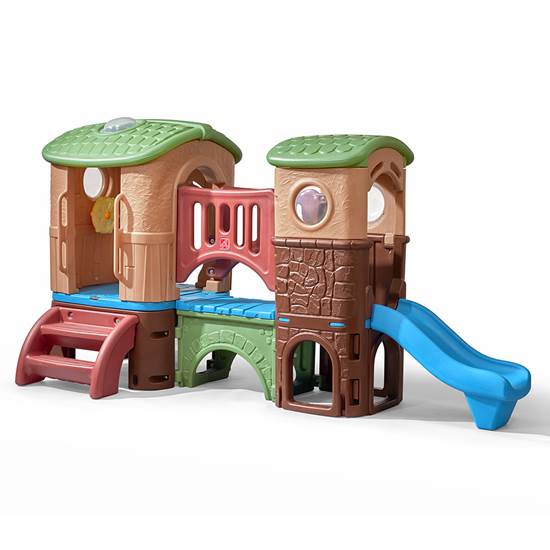Gorilla Playsets DIY Outing III Wooden Backyard Swing Set with Rock Wall, Wave Slide and play set accessories
Outdoor swing set w/ slide easily fits most yards and looks great. Playset helps build confidence with swings and a slide. Play structures offer classic fun for year-round enjoyment.
Have fun in your outdoor space with this DIY Outing III Wooden Swing Set with Rock Wall and Slide. Enjoy the alpine wave slide, rock wall with climbing rope, safe entry ladder, two belt swings, trapeze swing, built-in sandbox area, steering wheel and telescope. Perfect for children between three and eleven years old, this outdoor set features a rubber coating on the swing’s chains to prevent injuries. Its smart design fits in most backyards and comes ready for assembly. Instructions are included, providing step-by-step directions to make assembly easier. Other features include a vinyl canopy to offer shade on a sunny day. Meanwhile, a natural wood color finish complements existing outdoor decor.
- Ready to be assembled in your backyard over the weekend; compatible with most residential play equipment
- Heavy-duty vinyl canopy offers protection from the sun and provides shade and cooler temperatures
- Recommended for children aged 3 to 11 years; the solid 3 in. x 3 in. wood framing and 3-3/8″ x 5-3/8″ x 95″ swing beam allow the swing set to have a total weight capacity of 800 lbs.
- Soft rubber grippy plastic coating on swing chains helps prevent pinches and recessed bolts prevent snagging
- Charming design is packed into a compact footprint that fits in virtually any yard
- Natural wood color stain looks beautiful in all backyards and has superior resistance to rot, decay and insect damage
- 3-stations provide space for the included belt swings and trapeze bar; stations can accommodate any standard size swing component to allow for multiple playset configurations
- Includes an alpine wave slide, rock wall with climbing rope, safe entry ladder, 2 belt swings, trapeze swing, built-in sandbox area, steering wheel and telescope provide children with plenty of play options
- Comes ready-to-assemble with step-by-step assembly manual and all required hardware, all lumber is pre-cut and pre-sanded at the factory – even the main beams are pre-drilled to reduce the time of assembly
- We recommend a 6 ft. perimeter around the playset for added safety, which brings the total recommended footprint to 25.6 ft. W x 25 ft. D
- Meets and/or exceeds American Society of Testing Materials (ASTM) safety standards
- Unit is delivered curbside via freight truck, meaning it is your responsibility to move the product from the curbside to your desired location
- Play deck height of 4 ft. provides ample room for children to play under the deck
Additional information
| Assembled Depth x Height x Width (in.) | 156 x 126 x 162 |
|---|---|
| Chain/Rope Length (in.) | 58 |
| Minimum Recommended Play Area Length (ft.) | 25 |
| Certifications and Listings | ASTM Compliant |
| Manufacturer Warranty | Limited 10 Year Warranty on Lumber, 1 Year on Accessories |






by Eric
I was able too solo build this by myself. With a total of 12-14 hours total. 3 days with a few hours per day. Directions were awesome. Couldn’t make it any easier. Cut the ends of the boxes too expose wood id numbers, just go page by page. I would build another one. That’s how easy it was. My 3 year old loves it.
by Shaun
Excellent Playset. Very easy to assemble by myself. Lay out all the parts in groups before hand, use a cordless drill with bits and sockets and it will take you about 10 hours total.
by Miguel
Was intimidating at first. Wife lead the project and I followed directions. All worked out better than expected. Pretty sturdy and looks nice. Worth the price.
by Andrew
Nice for the money. Easy instructions. Took me about 12 hours to assemble.
by Dawn
Took a bit to assemble, but very happy with results.
by Julie
Great purchase. Arrived early. Perfect instructions.
by Greg
Great product! We bought a smaller one and took it back before we installed, this one is great, the slide is one piece and the set is very sturdy. The directions were very well depicted and easy to follow. We love it and the kids love it even more. Great Price!